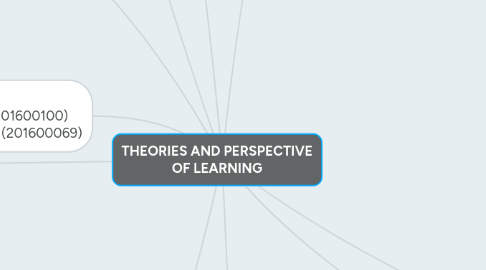
1. Logical Mathematical
1.1. Number smart
1.1.1. Scientist
1.1.2. Accountant
1.1.3. Engineer
2. Behaviourist theory
2.1. Ivan Pavlov
2.1.1. Classical conditioning
2.1.1.1. Before conditioning
2.1.1.1.1. Food
2.1.1.1.2. Bell
2.1.1.2. During classical conditioning
2.1.1.2.1. Food
2.1.1.2.2. Followed by
2.1.1.2.3. Bell
2.1.1.3. After classical conditioning
2.1.1.3.1. Bell
2.2. B.F. Skinner
2.2.1. Operant conditioning
2.2.1.1. Reinforcement
2.2.1.1.1. Positive (stimulus presented)
2.2.1.1.2. Negative (stimulus presented)
2.2.1.2. Punishment
2.2.1.2.1. Positive (stimulus presented)
2.2.1.2.2. Negative (stimulus presented)
3. Cognitive theory
3.1. Executive processes
3.1.1. Encoding
3.1.2. Attention
3.1.3. Perception
3.1.4. Complex
3.1.5. Forgetting
3.1.6. Rehearsal
3.2. Memory
3.2.1. Stage model
3.2.1.1. Sensory
3.2.1.2. Short - term
3.2.1.3. Long - term
3.2.2. Processes
3.2.2.1. Encoding
3.2.2.2. Storage
3.2.2.3. Retrieval
4. Multiple Intelligences
4.1. Bodily kinaesthetic
4.1.1. Body smart
4.1.1.1. Dance
4.1.1.2. Actor
4.1.1.3. Athlete
4.2. Activating experience
4.3. Linguistic
4.3.1. Word smart
4.3.1.1. Writer
4.3.1.2. Presenter
4.3.1.3. Lawyer
4.3.1.4. Comedian
4.4. Naturalist
4.4.1. Nature smart
4.4.1.1. Farmer
4.4.1.2. Gardener
4.4.1.3. Veterinarian
4.5. Musical
4.5.1. Music smart
4.5.1.1. Singer
4.5.1.2. Musician
4.5.1.3. Composer
4.6. Spatial
4.6.1. Picture smart
4.6.1.1. Artist
4.6.1.2. Architect
4.6.1.3. Photographer
4.6.1.4. Pilot
4.7. Interpersonal
4.7.1. People smart
4.7.1.1. Teacher
4.7.1.2. Doctor
4.7.1.3. Politician
4.7.2. Self smart
4.7.2.1. Writer
4.7.2.2. Philosopher
4.7.2.3. Researcher
5. Motivational theories and Emotion and Learning
5.1. Extrinsic
5.1.1. Operant conditioning
5.1.2. Social cognition
5.2. Intrinsic
5.2.1. Cognition
5.2.2. Social cognition
5.2.3. Biology
5.2.4. Affect
5.2.5. Spiritual
5.2.6. Conation
6. Name: Marilou(201600100) Christina (201600069)
7. People learn throughout their lives.
8. Constructivist Views
8.1. Jean Piaget
8.1.1. Cognitive constructivism
8.1.1.1. Concepts
8.1.1.1.1. Schema
8.1.1.1.2. Assimilation
8.1.1.1.3. Accommodation
8.1.1.1.4. Equilibration
8.1.1.2. Principles
8.1.1.2.1. Learning is an active rather than passive process.
8.1.1.2.2. Learning should be whole, authentic and "real" to be effective.
8.2. Lev Vygotsky
8.2.1. Social constructivism
8.2.1.1. Social interaction
8.2.1.2. Psychological tools
8.2.1.2.1. Language
8.2.1.3. The more knowledgeable other
8.2.1.4. Scaffolding
8.2.1.4.1. Tutoring
8.2.1.5. The zone of proximal development
9. Experiential Learning
9.1. Structure of the activity is important.
9.2. Design specifications
9.2.1. Framing the experience
9.2.2. Reflecting on experience
9.3. New node
9.4. Make sure that you discuss the experience in a timely manner.
9.5. Theoretical
9.5.1. Learning by doing
9.5.2. Experiential learning
9.5.3. Problem - centered learning
9.6. Relfection and feedback is important.
10. Learning styles
10.1. Honey - mumford model
10.1.1. Enthusiastic learning style
10.1.1.1. Doing
10.1.1.2. Feeling
10.1.2. Imaginative learning style
10.1.2.1. Feeling
10.1.2.2. Observing
10.1.3. Logical learning style
10.1.3.1. Observing
10.1.3.2. Thinking
10.1.4. Practical learning style
10.1.4.1. Doing
10.1.4.2. Thinking
10.2. Neuro - linguistic programming
10.2.1. Visual
10.2.2. Auditory
10.2.3. Kinaesthetic

